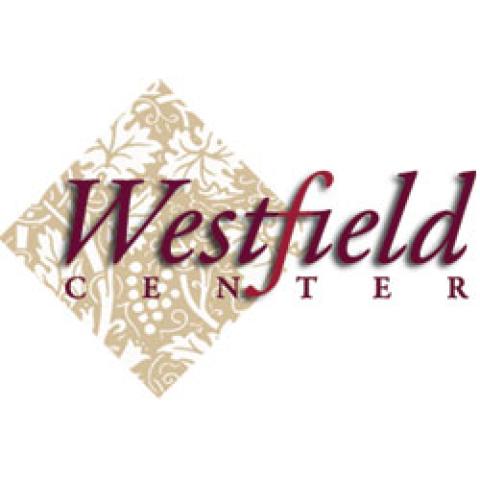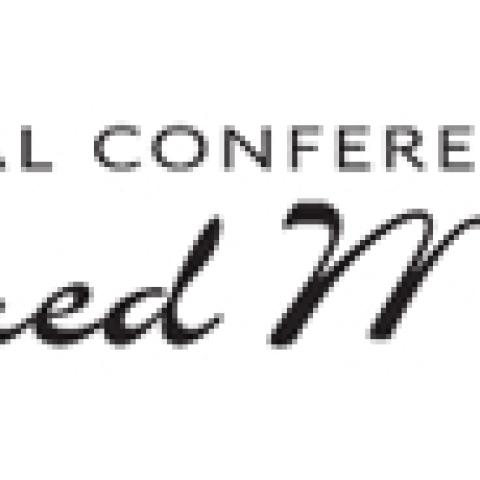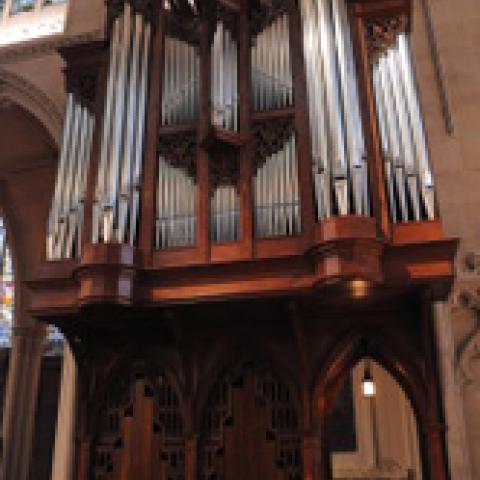A report by W. Michael Brittenback and Gordon Atkinson
The 43rd International Conference on Organ Music, Marilyn Mason, director, sponsored by the University of Michigan, was held October 5–8, 2003, in Ann Arbor and Ypsilanti, Michigan. The offerings this year represented Germany, Holland, France, Russia and the United States, and the organ music ranged from the beginnings of the North German-Dutch School through the twentieth century. The two cities of Ann Arbor and Ypsilanti, separated by only a street, boast three thriving university organ programs, and the conference showcased all three schools.
The festivities began with a traditional Lutheran hymn festival on Sunday evening at Concordia University Chapel with the choirs of Concordia University and St. Lorenz Lutheran Church, Frankenmuth, Michigan, conducted by Paul Altvogt, with Michele Johns and Scott Hyslop playing the large Schlicker organ.
On Monday morning the conference began at the University of Michigan School of Music with a lecture by William Gudger on the editing and performance of Handel’s organ concertos. On Tuesday he gave a recital of music by British composers (including Handel) at Eastern Michigan University. Dr. Gudger is currently on the faculty of the College of Charleston, Charleston, South Carolina, and is co-editor of the critical edition of the Opus 4 Organ Concertos of Handel.
The lecture was followed by a splendid recital of music of Sweelinck, Scheidt and Scheidemann given by Gail Archer, director of the music program at Barnard College, Columbia University, New York City, on the Marilyn Mason Organ built by Fisk. On Tuesday, Dr. Archer gave an animated lecture on performance practices of Sweelinck and his contemporaries as well as insights into the organs of the period.
Monday afternoon’s events were held at First Congregational Church of Ann Arbor, featuring the large three-manual Wilhelm organ. Marilyn Mason and Robert Luther gave an exciting recital of organ music for four hands and feet. For the last selection Dr. Mason was joined by pianist Seth Nelson playing the Classic Concerto for Organ and Piano by Leo Sowerby, one of the highlights of the day.
This was followed by a fine lecture on Russian organ music and organs in Russia by Iain Quinn, a Welsh organist and scholar. His lecture made everyone look forward to his recital on Tuesday on the fine Aeolian-Skinner organ at Pease Auditorium on the campus of Eastern Michigan. A recital by Matthew Bogart, Erin MacGorman, Seth Nelson, and Abigail Woods—students of the University of Michigan organ department—closed the afternoon’s events.
The day culminated with a splendid recital by Petr Plany, professor of organ at the University of Olomouc, Czech Republic, on the Létourneau organ at St. Francis Catholic Church in Ann Arbor. The evening began with one of the best performances of the Gothic Symphony in recent memory, and ended with music by the Czech composer Euben Reuchsel. On Wednesday Professor Plany gave an insightful lecture on the organ music and organs of the Czech Republic.
On Tuesday all events were held at Eastern Michigan and began with an exciting recital on the recently restored Aeolian-Skinner organ given by Donald Williams, professor of organ and university organist at Concordia University; Scott Elsholz, visiting instructor of organ at Eastern Michigan University; and James Wagner, adjunct faculty at Marygrove College. The program featured organ music of the 20th century. This was immediately followed with a recital given by Shin Ae Chun, Greg Hand, and David Saunders, graduate students of the organ department of the University of Michigan.
The afternoon events moved into the organ studio at Eastern Michigan where a fine three-manual Kney resides. After Dr. Archer’s lecture and Dr. Gudger’s recital, a discussion was led by Michele Johns, adjunct professor of church music at the University of Michigan, on “Recruitment and Positive People Skills for Church Musicians.” Dr. Johns was assisted by two students: Luke Davis and Kirsten Hellman.
The evening recital was given by Pamela Ruiter-Feenstra, professor of organ and university organist at Eastern Michigan, on the Aeolian-Skinner in Pease Auditorium. The program featured music by Demessieux, Boulanger, Olsson, Lindberg, and Bovet.
The final day was held at First Presbyterian Church of Ann Arbor, showcasing their new Schoenstein organ. The first event was a recital by students from the organ department of the University of Michigan and included Luke Davis, Michael Frisch, Kirsten Hellman, Andrew Herbruck, and Susan DeKam. This was followed by a masterclass in improvisation given by Justin Bischof, on the theory faculty of Manhattan School of Music and organist/choir director of Westchester Reform Temple. His teaching skill made the art of improvisation seem accessible to any musician. Next followed an improvised recital on hymn tunes suggested by the audience. Dr. Bischof performed convincing improvisations in the style of Max Reger, John Adams, and Messiaen, and then played a thirty-minute improvisation in his own style of a complete four-movement symphony for organ.
Following Petr Plany’s lecture on organ music of the Czech Republic, Joseph Daniel performed the final recital of the conference featuring music by Widor, Franck, and Duruflé.
The conference closed with a wonderful patio reception at the home of Marilyn Mason. The extraordinarily high caliber of all of the presenters and the variety of the material presented truly gave something for everyone who attended to learn and enjoy.
—W. Michael Brittenback
The University of Michigan’s 43rd Conference on Organ Music, “The European Connection,” was held October 5–8, 2003, and highlighted music from England, France, Germany, Holland, Russia and the United States. Three full days of organ music and lectures were preceded by the opening program at Holy Trinity Chapel, Concordia University, Ann Arbor, entitled “Oh, That I Had a Thousand Voices—Hymns, Psalms and Spiritual Songs for the Church Year.” The unique triangular shaped building with its stunning stained glass, reminiscent of that at Chartres (the artist Charles Loire’s studio is in Chartres) was an appropriate venue, particularly as the sun set. With important events in the church year outlined by the narrator, Rev. Stephen P. Starke, music was presented with opportunity for congregational participation. The choirs of Concordia University and St. Lorenz Lutheran Church, Frankenmuth, Michigan, with organ, brass quintet and handbells, provided strong leadership, and sang anthems by Alfred Fedak, Scott Hyslop, Martin How and K. Lee Scott. As a result of careful planning, there was great variety in the arrangements of hymns, with some verses sung by choir alone, solo verses, congregation alone, and instrumental solos, the latter affording the congregation time to reflect on the words. Conducted by Brian Altevogt, Andrew Schultz prepared the brass players, and Scott Hyslop was the organist. The 1963 Schlicker provided powerful accompaniment for the 300 people present.
Monday morning’s session, held in the Blanche Anderson Moore Hall at the University of Michigan, commenced with William Gudger’s lecture, “Editing and Performing Handel’s Organ Concertos.” He pointed out that the early concertos were intended for performance with the early oratorios. No. 4 with its “Alleluya” chorus was performed with Athalia, the chorus part founded on the material of the final fugue. This concerto, which is not a reworking of earlier compositions, can be called the first keyboard concerto by any composer. Concerning registration, the single-manual instruments contained two diapasons, one metal, one wood, with metal principals at 4’, 22/3’, 2’ and 13/5’; 4’ flutes were sometimes available. “Swiss cheese registrations” (8’ and 2’, 8’ and 22/3’) have no validity historically. In 1738 John Walsh published a transcription of the Six Concertos for the Harpsichord or Organ, making them available as solos for a single player. Of note, this edition was available by successors to Walsh and others until the late 1890s, when it was supplanted by romantic style editions with flamboyant cadenzas. An excellent handout was provided.
Gail Archer played music by Jan Pieterszoon Sweelinck and two of his many students, Samuel Scheidt and Heinrich Scheidemann, with great style and authentic registration. The Fisk Opus 87, which most closely resembles the Silbermann instrument in Rotha, Germany, was wholly appropriate for this recital.
At First Congregational Church, Marilyn Mason and Robert Luther played a program of duets, the commissioned Celebration of Two Hymn Tunes by Alice Jordan; Martyrs, op. 7 of Kenneth Leighton (“not for the faint-hearted, players or listeners”); and Concert Variations on Auld Lang Syne by Eugene Thayer. Dr. Mason, joined by Seth Nelson, played Leo Sowerby’s Classic Concerto with grace and style, the strings arranged for piano by the composer in 1948, in order “that there be more performances.” (I recall hearing Dr. Mason play this with strings conducted by Dr. Sowerby at Westminster Abbey for the International Congress of Organists in 1957.) The Karl Wilhelm instrument is always a joy to hear.
Two recitals and lectures featured music from countries of which many musicians know little, the first by Iain Quinn in his lecture, “The Tsar of Instruments.” He gave an overview of the history of the organ in Russia from Byzantine times to J. S. Bach and beyond. Organs from Holland and England were owned by the nobility, as organs had no place in the Orthodox liturgical world and were denounced by church authorities. During the time of Peter the Great, the mid-18th century, an interest in the culture of Europe developed, and more organs were imported, including those of Arp Schnitger. European artists made tours. Johann Wilhelm Hassler (1747–1822) influenced the musical life of Moscow and introduced the music of J. S. Bach to Russia. The 19th century saw the importation of organs by Walcker, Sauer, Steinmeyer and Ladegast from Germany; from England those by Brindley and Foster; and the Cavaillé-Coll from France for the Moscow Conservatory. Liszt, Widor, Tournemire and Bossi made tours, Widor playing five of his symphonies in one concert. Newly established organ departments of the conservatories of St. Petersburg and Moscow had “non-ecclesiastical” organ studies. A helpful handout of publications listing compositions by Glasunov (“arguably the most important Russian organ composer”), Gretchaninov, Glière, Glinka, Rachmaninov (an Andante for harmonium from Trio elegiaque, written in memory of Tchaikovsky) and Shostakovich shows the extent of organ compositions in the 19th and first half of the 20th centuries.
A daily addition to the conference featured recitals by students in the organ department from the studios of Marilyn Mason, Robert Glasgow and James Kibbie. Matthew Bogart, Abigail Woods, Stephanie Muller, Seth Nelson and Erin MacGorman concluded the afternoon sessions.
That night at St. Francis Catholic Church (Létourneau organ), Petr Plany of the University of Olomouc, Czech Republic, played a program which opened with Widor’s Gothic Symphony. The last movement with its numerous tempi changes was stunningly performed, the player, organ and the building’s sympathetic acoustics a fine match. Chorale preludes and a Prelude and Fugue in f by B. A. Wiedermann (1883–1951) and Promenades en Provence by Eulen Reuchsel (1900–1988) completed the evening.
Tuesday’s events were held at Eastern Michigan University, Ypsilanti. At Pease Auditorium with its 1960 Aeolian-Skinner recently restored by Schoenstein, Donald Williams opened the first program with Vincent Persichetti’s chorale prelude Give peace in our time, O Lord, the melody introduced by Sally Carpenter, alto. James Wagner played Messiaen’s Consecration and Apparition de l’Eglise eternelle. Calvin Hampton’s Five Dances were played by Scott Elsholz. In the second recital by students of the School of Music, David Saunders, Gregory Hand and Shin-Ae-Chun were heard. In Iain Quinn’s recital he played much of the music he had discussed the previous day. Of particular interest were the Prelude and Fugue in D, op. 93, and Prelude and Fugue in d, op. 98, of Glasunov.
In the organ studio of the Alexander Building with its 1982 Gabriel Kney instrument, Gail Archer shared her enthusiasm for Sweelinck and his disciples in her lecture, “The Foundation of the North German School,” stressing the tuning of instruments and the fingering used. An invaluable handout included the stoplists of the Oude Kerk in Amsterdam, where Sweelinck as civic organist played daily recitals, and St. Moritz’s Church, Halle, where Scheidt was organist; his instructions for playing chorale-based pieces were also included. “Rules for the Organist in the City of Leiden” (1607) directed that recitals start and end on “ . . . the Principal and in between [he] will use and play all the stops . . . ” Slides were shown of churches in Germany where this music can be performed authentically.
Dr. Gudger’s recital featured English music from the 18th to the 20th centuries, with works by William Walond, Handel (Concerto No. 4), Samuel Wesley, Samuel Sebastian Wesley, Charles Villiers Stanford, and Herbert Howells. Again a handout provided much pertinent information.
For the last part of the afternoon, Michele Johns introduced “Recruitment and Positive People Skills for Church Musicians,” presented by Luke Davis and Kirsten Hellman. In the short time available the audience was divided into small groups in which situations both positive and negative were discussed, some of which were reported at the end of the session. From their research, the presenters defined problems and positive ways in which they could be met.
The evening program at Pease Auditorium, played by Pamela Ruiter-Feenstra, professor and university organist at EMU, featured French music by Jeanne Demessieux and Nadia Boulanger, and Swedish music by Otto Olsson and Oskar Lindberg. The 1935 Prelude and Fugue in d# (!) of Olsson was exciting in its intensity, and Guy Bovet’s well-known Salamanca concluded a delightful evening.
Wednesday, October 8, at First Presbyterian Church, Ann Arbor (with its 2002 Schoenstein organ), commenced with the third program by organ students of the School of Music: Luke Davis, Ben La Prairie, Kirsten Hellman, Michael Frisch, Susan de Kam and Andrew Herbruck. For the second time in the conference a composition for organ and piano was featured, Dupré’s Ballade for Piano and Organ dedicated to his daughter, Marguerite, played by de Kam and Herbruck. In his lecture on improvisation, Justin Bischof said that technique in this art form must be developed, by practicing regularly and striving for excellence. He suggested using as a basis I-IV-V-I, keeping the forward movement in strict time. As one progresses one could move to I-I6-IV-IV6-V-V7-I. In playing a hymn, solo the treble line, then put the melody in the pedal, followed by the melody with a different pedal line from that written (using part of the printed chord), and finally adding other chords. Two people volunteered (or were conscripted) to illustrate his suggestions. Dr. Bischof requested hymn tunes from the audience on which he improvised short pieces. His improvisation in the style of Reger demonstrated his familiarity with the composer’s style. The final piece, in which were quotations from several sources, was a brilliant tour de force.
Petr Plany’s noteworthy lecture included many recorded examples. Composers who wrote prolifically for the organ included J. F. N. Seger (1716–1782), B. A. Wiedermann (1883–1951), and major contributions from present-day Jiri Ropek and Petr Eben. Dvorák and Janácek, probably the best known Czech composers, wrote little for the instrument, the former various preludes and fugues, of which the one in D was heard, and the latter some short adagios, apart from the monumental Postlude of his Glagolitic Mass. An extensive handout provided much information concerning composers from the 17th century to the present day, as well as stoplists, manual compasses and the names of organ builders.
In the final recital, Joseph Daniel performed movements from Widor’s Symphony No. 4, Franck’s Choral in a, and the Choral Variations on Veni Creator Spiritus of Duruflé, the alternatim sung by David Hoffman. The conference concluded with a reception at the home of Marilyn Mason and her husband, Dr. William Steinhoff.
As always, The University of Michigan presented a fine conference with time allowed for relaxation. There was much compelling playing by the students with thanks due their teachers, Marilyn Mason, Robert Glasgow and James Kibbie. Conferees from 12 states appreciated the organizational skills of Dr. Mason and Dr. Johns. It was a time for listening, learning, discussion, meeting old friends and making new ones. After being closed for almost two years for restoration and improvement it will be a delight to be at Hill Auditorium for the 44th Conference in October 2004.
—Gordon Atkinson






